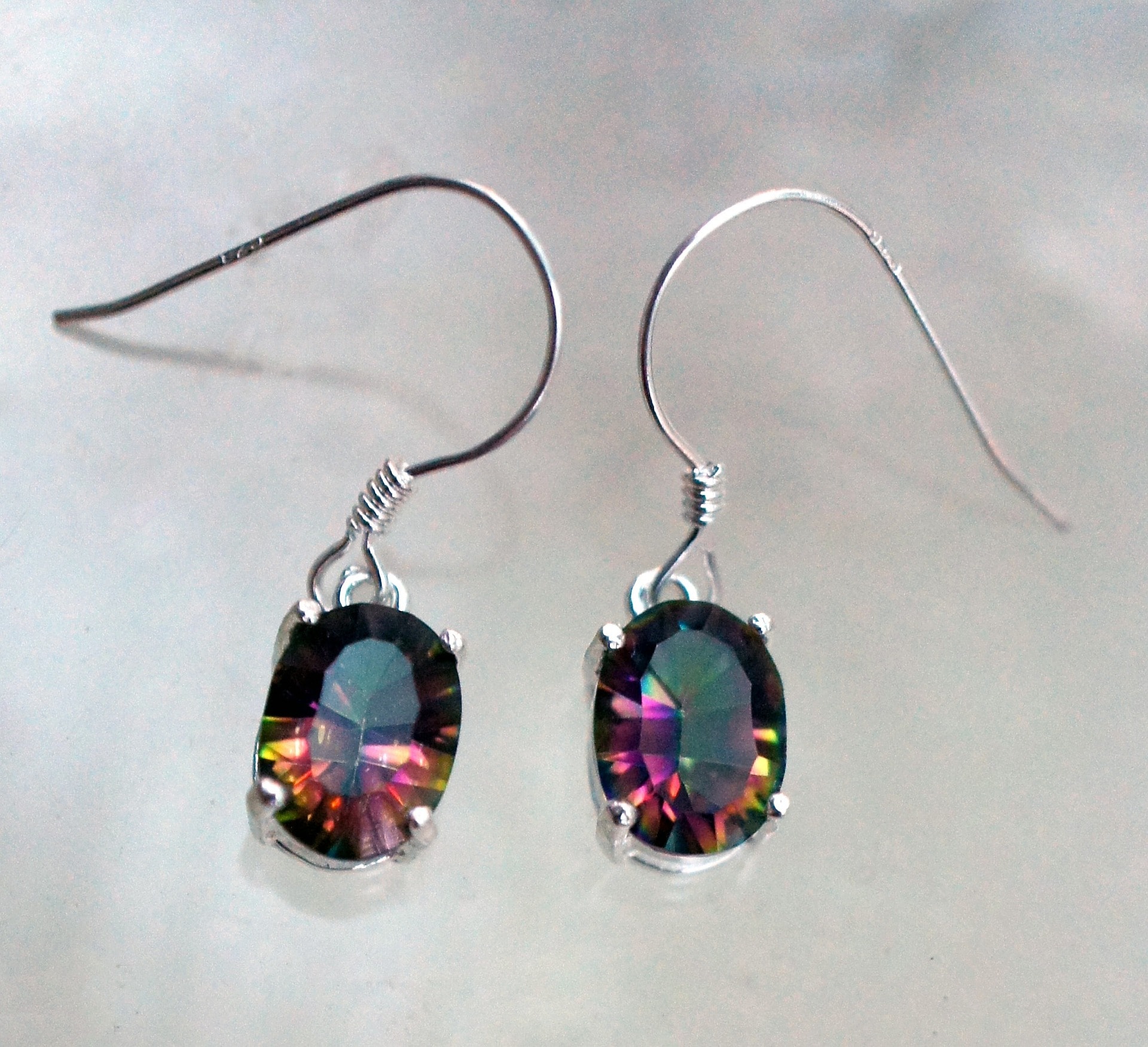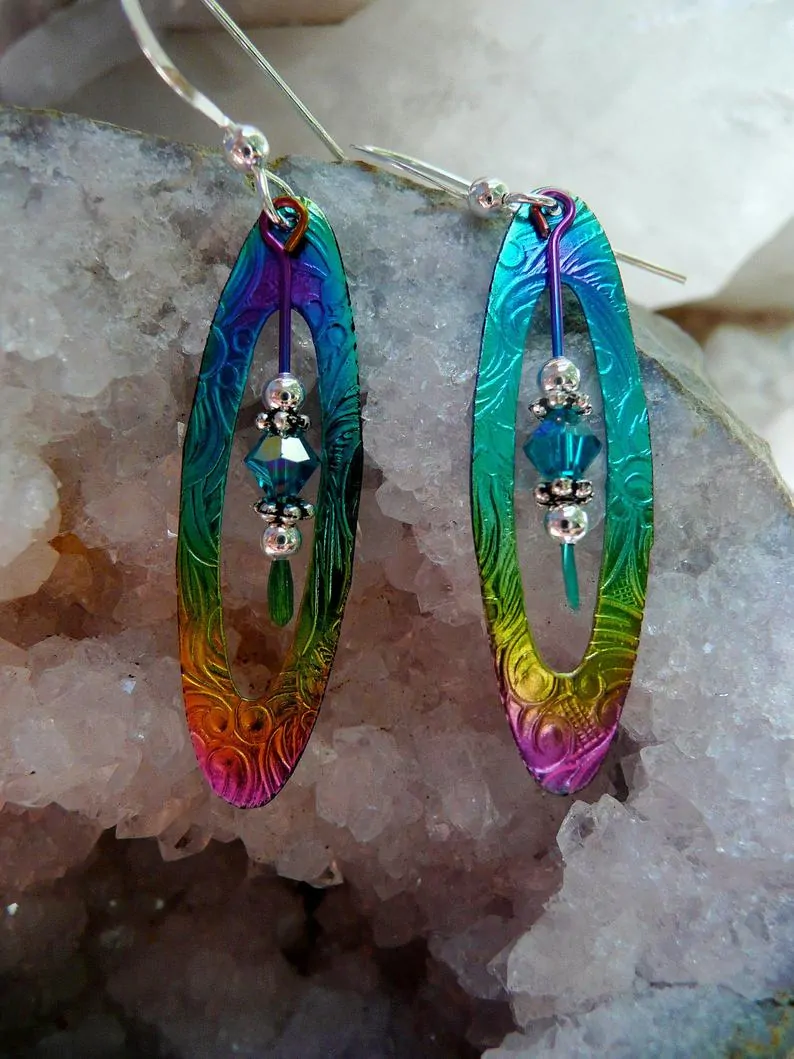
Table of Contents
As Jewelry Shopping Guide editors, we write about things that we love and we think you’ll like too. We often have affiliate partnerships, and may generate some revenue from these links at no cost to you.
Not many people have heard of niobium, but if you’ve got metal allergies or are looking for a unique, naturally colorful metal, then this might be the perfect option for you.
Niobium is rare, relatively valuable and similar in appearance to metals like platinum or titanium. However, when anodized, it showcases unique, iridescent colors that make for eye-catching jewelry. And the best part is, it’s hypoallergenic and extremely safe to wear.
If you’re intrigued, keep reading.
Let’s take a look at why buying niobium jewelry is a great choice.
What is Niobium?

Niobium is a gray colored element that was discovered in the 1800s, by chemist Charles Hatchett. It’s produced both as a pure metal and in alloys. Niobium has been used in medical devices including pacemakers and prosthetics and has applications in jewelry, technology, jet engines and even railroad tracks.
While it’s not a precious metal (that honor goes to gold, platinum, palladium and silver), its value is more than that of silver and it’s definitely valued much higher than industrial metals such as tungsten, titanium or stainless steel.
Let’s take a look at the pros of niobium and what makes it a great choice in jewelry.
Pros of Niobium in Jewelry
1- Niobium’s Rainbow Colors
One way in which niobium stands out from other metals is its ability to reflect iridescent hues on its surface. These colors occur when niobium is heated and anodized.

What happens is that the metal is placed in a bath and given an electric charge. This causes a transparent oxide film that clings to the surface and creates the array of colors.
You could compare these surface colors to a patina that forms on metals like platinum. The difference, however, is that this is a chemically stable phenomenon and will not alter with time. These colors, unlike plating, will not flake or wear off. Not only does this mean that the funky colors are permanent, but they’re also safe to wear.
2- Niobium’s Hypoallergenic Properties
If you have metal sensitivities or are looking for a safe metal to wear for fresh body piercings, niobium is a perfect option. It’s nickel-free and contains no allergens. It’s bio-compatible nature is why this metal is used in surgical implants and for medical devices. It’s especially ideal for those with sensitive ears and is commonly used in earring hooks, or any part of the jewelry design that has contact with the body.
3- Niobium Rarity
Niobium is a rare metal, with demand and interest in it increasing over the last few years. There are no good substitutes for niobium making it a ‘strategic metal’ and one that is highly sought after by investors and organizations around the world. Niobium only makes up a small percentage in jewelry, meaning that niobium jewelry is truly rare and unique.

4- Niobium Price
While niobium isn’t as inexpensive as some other metals used in jewelry, it’s much more affordable than precious metals. The price point sits somewhere above silver. For example, compare the prices of this solid niobium hammered cuff with this similar sterling silver cuff. The niobium is about 50% higher in price.
When looking for niobium jewelry, the price will be impacted by the quality of craftsmanship, design and brand name.
5- Niobium Durability
Niobium is a hard metal that is scratch resistant and highly durable. Due to its strength, niobium is found in alloys used in industrial applications, like in aircraft engines and oil rigs.
6- Niobium Malleability
Niobium is a workable, malleable metal that’s easy to shape and form. This makes it perfect for more intricate designs and can easily be cut and forged.
7- A Lightweight Metal
Niobium is lightweight and easy to wear. It’s about 60% lighter than stainless steel of the same size, which is considerable.
8- Easy to Maintain
One main benefit of niobium is the minimal maintenance required to keep it lustrous and shiny. The metal is highly resistant to corrosion and tarnishing. Because the surface colors don’t flake off or wear away, you don’t need to periodically replate it as you would white gold. Simply using water and a mild soap is enough to keep it clean and lustrous.
With all these benefits, you might be wondering if there are any downsides in choosing niobium. As with every metal, there are cons that come with niobium. But try as we might, we could only come up with one.
Cons of Niobium in Jewelry
1- Limited Options
Because niobium is rare and isn’t a mainstream metal used in jewelry, you won’t find a lot of jewelry designs featuring niobium. Most niobium jewelry feature wire-style designs and the metal is more commonly used in small rings and earrings. It takes some searching to find niobium jewelry that really stands out and makes a statement.
Where to Find Niobium Jewelry
Finding niobium jewelry at the local brick and mortar store might prove to be difficult. If you’re looking for niobium jewelry, we suggest starting your search online, as this will give you more options and competitive prices.
Etsy offers a range of hand-crafted, unique niobium jewelry at a range of prices and in a variety of designs. It’s worth taking some time to sift through the collection to find a piece you’ll fall in love with.
Amazon also offers an excellent range of niobium jewelry. We especially love the range of colorful niobium dangle earrings on offer, each unique and stylish.
Ready to start looking? Browse niobium jewelry here.









